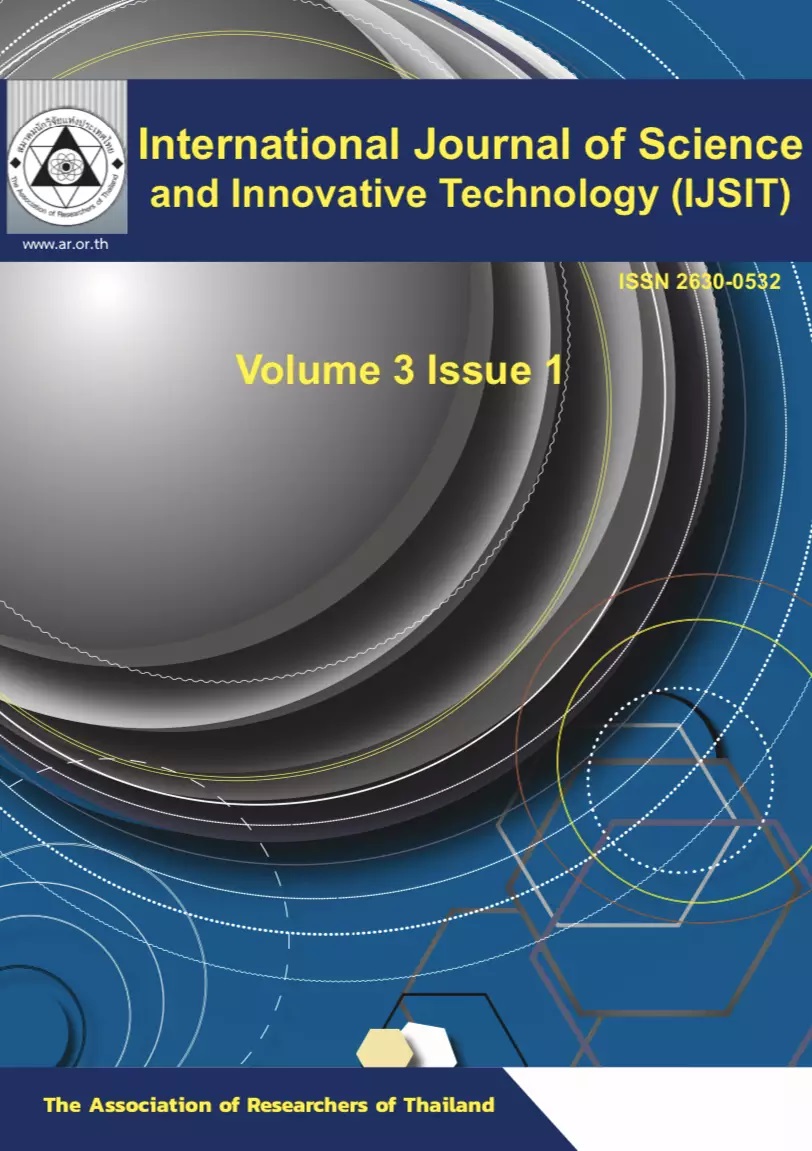Effects of Coconut Coir Powders on the properties of Natural Rubber Composites
Main Article Content
Abstract
In this work, the coconut coir powders (CCP)/natural rubber (NR) composites were successfully prepared. The CCP acts as a reinforcing filler with two different sizes of fine powders (39 um) and coarse powders (101 um). The coconut coir powders added to the natural rubber matrix at the filler content of 25, 50, 75, and 100 phr. The effect of CCP contents on physical and mechanical properties was studied. The result revealed that the increase in CCP content has decreased the tensile strength and elongation at break of composites but increased the modulus of elasticity. The CCP/NR composite at 25 phr of filler loading shows better mechanical properties, whereas the CCP filler loading of 100 phr presented excellent hardness. For different sizes of fillers, the F-CCP exhibit the better mechanical properties compare to C-CCP.
Article Details
References
Faruk, O., Bledzki, A. K., Fink, H.-P., & Sain, M. (2012). Biocomposites reinforced with natural fibers: 2000–2010. Progress in Polymer Science, 37(11), 1552-1596. doi:https://doi.org/10.1016/j.progpolymsci.2012.04.003
Geethamma, V. G., Thomas Mathew, K., Lakshminarayanan, R., & Thomas, S. (1998). Composite of short coir fibres and natural rubber: effect of chemical modification, loading and orientation of fibre. Polymer, 39(6), 1483-1491. doi:https://doi.org/10.1016/S0032-3861(97)00422-9
Herrera-Franco, P. J., & Valadez-González, A. (2004). Mechanical properties of continuous natural fibre-reinforced polymer composites. Composites Part A: Applied Science and Manufacturing, 35(3), 339-345. doi:https://doi.org/10.1016/j.compositesa.2003.09.012
Islam, M., Das, S., Saha, J., Paul, D., Islam, M., Rahman, M., & Khan, M. (2017). Effect of Coconut Shell Powder as Filler on the Mechanical Properties of Coir-polyester Composites. Chemical and Materials Engineering, 5, 75-82. doi:10.13189/cme.2017.050401
Ismail, H., Edyham, M. R., & Wirjosentono, B. (2002). Bamboo fibre filled natural rubber composites: the effects of filler loading and bonding agent. Polymer Testing, 21(2), 139-144. doi:https://doi.org/10.1016/S0142-9418(01)00060-5
Kaewduang, M., Chaichana, E., Jongsomjit, B., & Jaturapiree, A. (2015). Use of coir-filled LLDPE as a reinforcement for natural rubber composite. Paper presented at the Key Engineering Materials.
Luz, S. M., Gonçalves, A. R., & Del’Arco, A. P. (2007). Mechanical behavior and microstructural analysis of sugarcane bagasse fibers reinforced polypropylene composites. Composites Part A: Applied Science and Manufacturing, 38(6), 1455-1461. doi:https://doi.org/10.1016/j.compositesa.2007.01.014
Macedo, J. d. S., Costa, M. F., Tavares, M. I. B., & Thiré, R. M. S. M. (2010). Preparation and characterization of composites based on polyhydroxybutyrate and waste powder from coconut fibers processing. Polymer Engineering & Science, 50(7), 1466-1475. doi:10.1002/pen.21669
Monteiro, S. N., Terrones, L. A. H., & D’Almeida, J. R. M. (2008). Mechanical performance of coir fiber/polyester composites. Polymer Testing, 27(5), 591-595. doi:10.1016/j.polymertesting.2008.03.003
Noor Leha, A. R., & Nordin, N. A. (2014). Effect of Filler Compositions on the Mechanical Properties of Bamboo Filled Polyester Composite. Advanced Materials Research, 879, 90-95. doi:10.4028/www.scientific.net/AMR.879.90
Panthapulakkal, S., Zereshkian, A., & Sain, M. (2006). Preparation and characterization of wheat straw fibers for reinforcing application in injection molded thermoplastic composites. Bioresource Technology, 97(2), 265-272. doi:https://doi.org/10.1016/j.biortech.2005.02.043
Parambath Kanoth, B., Thomas, T., Joseph, J. M., & Narayanankutty, S. K. (2019). Restructuring of coir to microfibers for enhanced reinforcement in natural rubber. Polymer Composites, 40(1), 414-423. doi:10.1002/pc.24667
Sareena, C., Ramesan, M. T., & Purushothaman, E. (2012). Utilization of coconut shell powder as a novel filler in natural rubber. Journal of Reinforced Plastics and Composites, 31, 533-547. doi:10.1177/0731684412439116
Sarki, J., Hassan, S. B., Aigbodion, V. S., & Oghenevweta, J. E. (2011). Potential of using coconut shell particle fillers in eco-composite materials. Journal of Alloys and Compounds, 509(5), 2381-2385. doi:https://doi.org/10.1016/j.jallcom.2010.11.025
Swapna, V. P., Stephen, R., Greeshma, T., Sharan Dev, C., & Sreekala, M. S. (2016). Mechanical and swelling behavior of green nanocomposites of natural rubber latex and tubular shaped halloysite nano clay. Polymer Composites, 37(2), 602-611. doi:10.1002/pc.23217
Wongsorat, W., Suppakarn, N., & Jarukumjorn, K. (2014). Effects of compatibilizer type and fiber loading on mechanical properties and cure characteristics of sisal fiber/natural rubber composites. Journal of Composite Materials, 48(19), 2401-2411. doi:10.1177/0021998313498790


